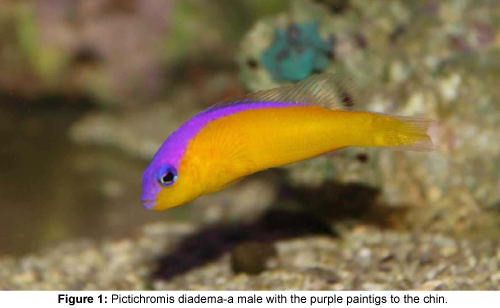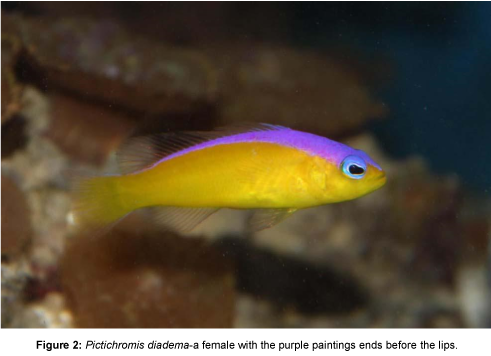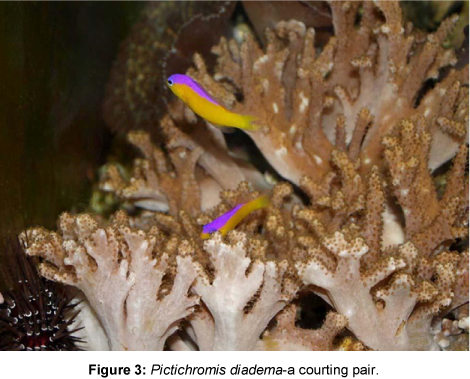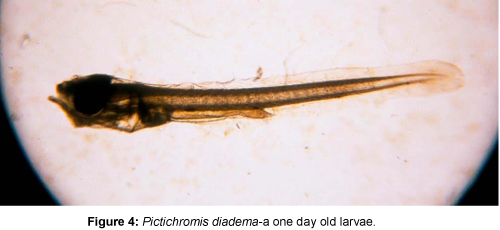Perspective Article Open Access
View in a tank: A Misjudged Ruffian - The Diadem Dottyback (Pictichromis diadema LUBBOCK and RANDALL 1978)
Luty A*Contributed fish pictures to FishBase, Germany
- Corresponding Author:
- Luty A
Contributed fish pictures to FishBase
Germany
Tel: (450) 689-6425
E-mail: luty-loewner@t-online.de
Received date March 15, 2016; Accepted date April 24, 2016; Published date May 02, 2016
Citation: Luty A (2016) View in a tank: A Misjudged Ruffian - The Diadem Dottyback (Pictichromis diadema LUBBOCK and RANDALL 1978). J Fisheries Livest Prod 4:185. doi: 10.4172/2332-2608.1000185
Copyright: © 2016 Luty A. This is an open-access article distributed under the terms of the Creative Commons Attribution License, which permits unrestricted use, distribution, and reproduction in any medium, provided the original author and source are credited.
Visit for more related articles at Journal of Fisheries & Livestock Production
Experience in Tank Care
This attractive dotty back is descripting in many publications as a fighter against other tank fishes, but I think the cause is a wrong care. This species need a diverse structured decoration with many small microhabitat and a for the small fish relative big swimming roam. The individual territory is about 0.5-1 m in diameter. This is not a fish for nano-tanks! The territories of males and females can overlap in parts. The sex-differentiation is easy: You must look to the mouth. Is the red colour over the two lips to the chin-this is a male (Figure 1), ends the red before the lips – it is a female (Figure 2). The male swims several times a day little aggressively to the female, to demonstrate his dominance. Damages in the female are possible-mostly in too small tanks without hiding place possibilities [1,2].
In big tanks males and females swims also sometimes together, with a distance of about 10 cm. In the evening-in my tank after 16:00 o'clock-the male starts to court, the male swims to the female, they stand side by side and they wave the body. After some times, the male lures the female with jerky swimming to his breeding cave (Figure 3).
Two males do not get on-they will fight and fight. In a (small) tank is the bidirectional sexual development not possible (in nature it is possible if the males are not too old). It is better to compose two females in a large tank ore in two smaller tank-parts, where the interaction between the females is possible-and one should be a functional male after some weeks. But the compose of two fishes of this species has always a rest risk. This mini-predator (in nature it feeds mostly small crustaceans fish larvae) accept the mostly typical aquarium-feed (cyclops, lobster eggs, brine shrimp, nori-algae, small granulates-but not every granulate were accept). To eat flakes they need more time. With repeated feeding per day in small portions you can minimize the aggressivity of the fishes (Figure 4).
| Family | Pseudochromidae |
| Distribution | West Central Pazifik between Malaysia, the Philippines and northern Borneo |
| Habitat | Coral reefs in zones with turbulent waters and rich coralgrowth, groups(harems?) among corals and rocks, deep 5 - 30 m |
| Social behavior | groups, every small individual defend his own territory, males fight extremely,but they are protogyne hermaphrodites and can change his sex in some weeks |
| Size: | 6 cm TL |
| Tanks: | pairs in over 500 liter |
Table 1: Information regarding family Pseudochromidae.
Conspicuously in proportion to other dotty backs like Pseudochromis friedmanni this species swims less between the decoration-more over the tank reef. For sessile invertebrates like corals this fish is harmless. Small crustaceans were feed. Lysmata-shrimps were killed sometimes, when they carry eggs. They also can loot a nest of anemonefishes. So I think this species need fish- and crustacean-eggs also in the reef. Small fishes were mostly attack than the bigger. But they attack in my 500-litertank the bigger wrasse Paracheilinus mccoskeri aggressively still to the end (the wrasse was older in the tank!). They attack more seldom the Elegant fire fish (Nemateleotris decora) or Damsels (Chrysiptera hemicyanea). In one tank I know from a fish which attacks a file fish (Arceichthys tomentosus). Other like Amphiprion ocellaris, Acanthurus japonicus, Genicanthus melanospilos, Pervagor melanocephalus and Synchiropus splendidus, a single Lysmata debelius and Alpheus soror were not attacked. The captative breeding of this species is realised and is like the breeding of Pseudochromis fridmanni -only if you had a pair (Table 1).
References
- Gill AC (2004) Revision of the Indo-Pacific dottyback fish subfamily Pseudochrominae (Perciformes: Pseudochromidae). Smithiana Monographs University of California, 1-213.
- Luta A (2014) Ein verkannter Raufbold - Diadem-Zwergbarsch (Pictichromis diadema LUBBOCK & RANDALL 1978), Der MeerwasserAquarianer 18/2: 26-27.
Relevant Topics
- Acoustic Survey
- Animal Husbandry
- Aquaculture Developement
- Bioacoustics
- Biological Diversity
- Dropline
- Fisheries
- Fisheries Management
- Fishing Vessel
- Gillnet
- Jigging
- Livestock Nutrition
- Livestock Production
- Marine
- Marine Fish
- Maritime Policy
- Pelagic Fish
- Poultry
- Sustainable fishery
- Sustainable Fishing
- Trawling
Recommended Journals
Article Tools
Article Usage
- Total views: 11045
- [From(publication date):
September-2016 - Mar 29, 2025] - Breakdown by view type
- HTML page views : 10162
- PDF downloads : 883




